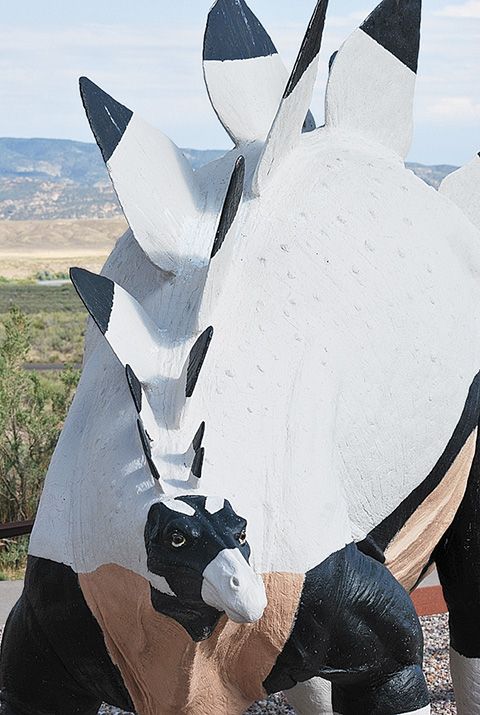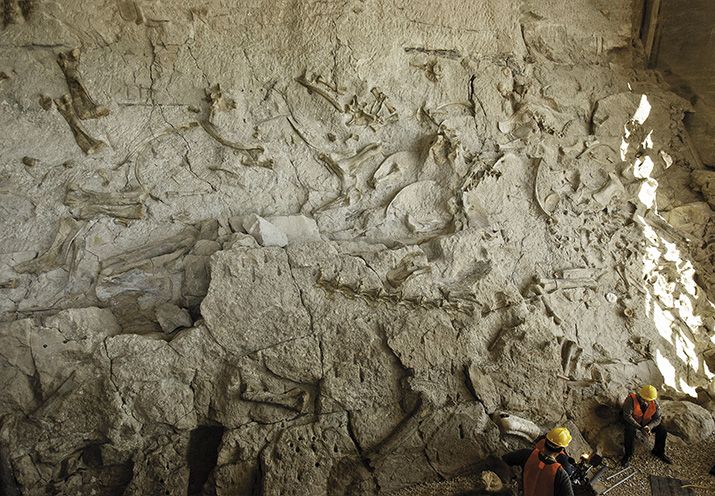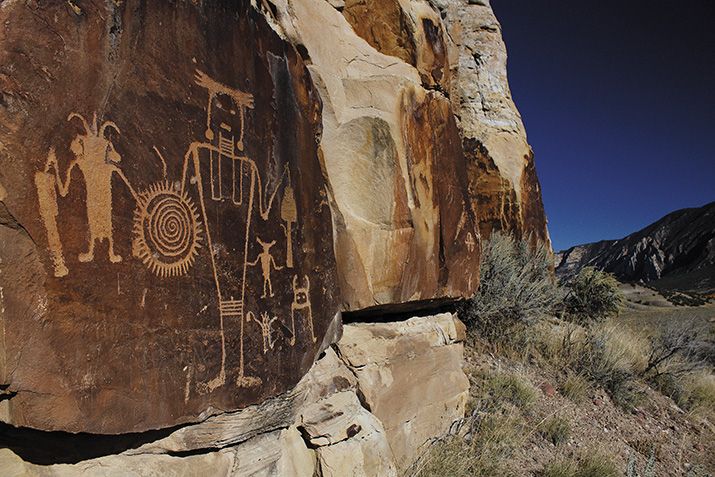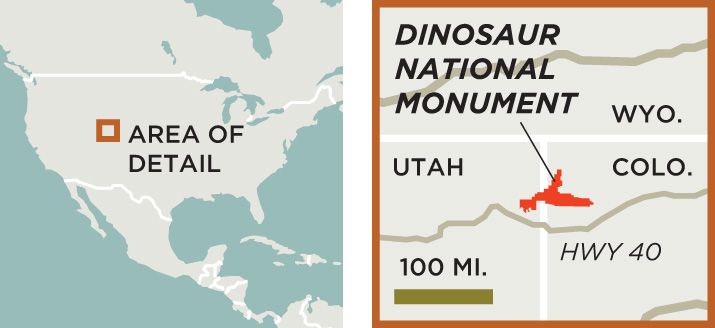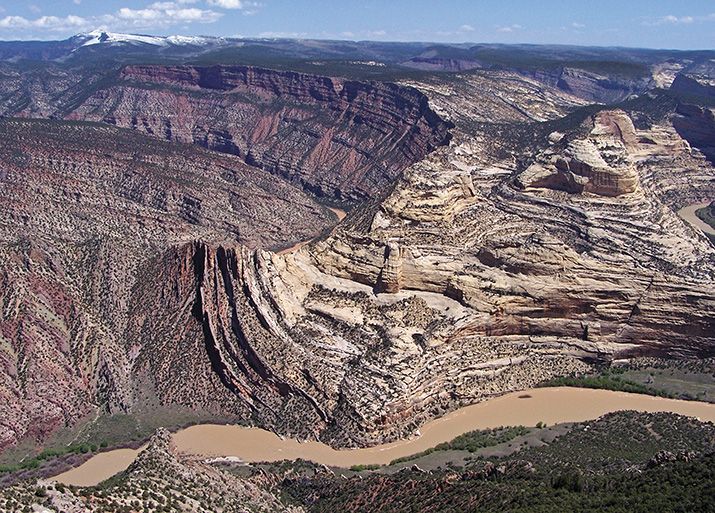Welcome to America’s Dinosaur Playground
Countless bones and a billion years of geological action make Dinosaur National Monument the go-to park for fossil finds
/https://tf-cmsv2-smithsonianmag-media.s3.amazonaws.com/filer/America-Dinosaur-Playground-Green-River-631.jpg)
A visit to Dinosaur National Monument begins with the usual preposterousness of scale. A life-size Stegosaurus takes up the equivalent of three parking spaces next to the visitor center lot, and a four-foot-long Diplodocus thighbone, mounted on end, is positioned near the entrance like a greeter. But within a minute or two, it’s clear this isn’t your typical dinosaur exhibit. A ranger sidles up to steer your attention to a shuttle bus idling on the far side of the building. The main event is half a mile away, hidden from view in the rubbly hills that make up the Uintah Basin terrain due east of Vernal, Utah.
I board the shuttle behind a family of Australians. “Here we go!” says the mom in her lovely corkscrewed accent. “Jur-issick Park!” She is right about the Jurissick bit. Dinosaur National Monument is the world’s most impressive public collection of Jurassic Period dinosaurs. But there are no animatronics here, no towering, gape-jawed T. rex skeletons. The star attraction—the awesome, bone-crushing giant—is earth itself. Dinosaur National Monument is about the vastness of time, not the vastness of thighs.
Below our feet is hundreds of millions of years of settled geological detritus—sand on silt on drifted volcanic ash, each layer compressed by the growing weight above it. It’s a massive stone lasagna, its layers packed with fossil clues to earth’s distant past: What creatures walked the Uintah Basin 150 million years before the Utes and the Mormons and the Burger Kings arrived? What stood where Jiffy’s pawn shop and Undercarriage Mud Wash stand now? Paleontologists don’t have the equipment or budget to reach the answers by digging, so they let the earth lend a hand. This it does through the twin powerhouses of uplift and erosion. Stay with me, please. This is very cool.
When geological plates collide, an ultra-slow-motion buckling erupts along the line of impact. Over millennia, the thrust-up lasagna, its layers still tidily stacked, forms mountains and “anticlines”—up-bowed sediment now repositioned thousands of feet above sea level. In a desert clime like eastern Utah’s, rainfall and windblown sand easily erode the uppermost layers, revealing the more ancient ones below. Returning to my clunky lasagna metaphor, erosion is the unsupervised dog in the kitchen. It licks away the Parmesan Crust, the Upper Sauce Layer, the Spinach Formation. On the southern flank of Dinosaur’s Split Mountain Anticline, uplift and erosion have brought into view a 150-million-year-old riverbed strewn with the bones of ten different species of Jurassic dinosaurs: Stegosaurus, Allosaurus, Camarasaurus, Apatosaurus...the Hamburger Layer!
Earl Douglass, a paleontologist in the employ of Pittsburgh’s Carnegie Museum, discovered this site on a fossil-hunting expedition in 1909. A strand of eight Apatosaurus tailbones first snagged his gaze. Excavations over the ensuing decades unearthed hundreds of thousands of pounds of fossils, laboriously extracted from the stone with hand pick and wedge and then sledge-hauled out for shipment to Pittsburgh. Eventually the Carnegie exhibit halls (and basement and closets) could hold no more, and Douglass and his crew moved on. The famous quarry wall of Dinosaur National Monument is the leftovers, but there is nothing catch as catch can about it. More than 1,500 dinosaur bones remain in place. They have been showcased through a painstaking process called reliefing—chipping away surrounding rock—but are otherwise as prehistory left them.
It was Douglass who had the idea to turn the fossil wall into a natural museum. “How appropriate to build a fair sized building over them to protect them,” he wrote in his low-key, anti-hyperbolic prose. “...To have it large enough to contain related fossils and...explanatory descriptions, pictures, paintings to represent scenes in the age in which they lived.” The journal entry is dated October 29, 1915. The Great Depression and institutional apathy got in the way, but in 1958, that is what America came to have. The “fair sized building” doesn’t just protect the bones; it comprises them. The fossil-studded face serves as the building’s fourth wall.
Every visitor’s first question is invariably the same: Why did so many dinosaurs die here? The quarry wall holds bones from more than 400 individuals. The prevailing theory is that they didn’t, in fact, die here; they died elsewhere and were carried to this spot on a raging current. An epic drought caused a dinosaur die-off, and was followed, the thinking goes, by an equally epic flood. Remains of these creatures were swept into the cleft of the valley and borne along until the floodwaters receded and the current slowed and they drifted to the river bottom. Unfortunately for paleontologists, the bodies were by this time no longer intact. They had come apart as they decomposed and tumbled through the river. In many cases, scavengers may have torn away limbs, so the bones of extremities landed far afield from their torsos. The riverbed’s fossils are scattered and chaotic, toe bones inside the curve of a rib, a Diplodocus leg bone beside a run of Camptosaurus backbones. It’s as if a tornado touched down in a natural history museum.
Staring at the fossil wall, you appreciate the enormousness not just of the reptiles themselves, but of the paleontologist’s challenge in reconstructing them. Whose (relatively) small head is this? Did it belong to someone’s offspring, or is it a different kind of beast altogether? A complete dinosaur skeleton preserved as it fell is a rare thing, and far more often the paleontologist confronts a jumbled mess like the one on display in Dinosaur National Monument. Some prehistoric birds were especially tricky for paleontologists, because distinctive features like skull crests didn’t show up until maturity. “So the babies look like different species,” says ranger Erin Cahill. “Excuse me.” She turns to address a grade-schooler poised to scale a low section of wall. Her voice drops an octave. “Get down, please!” (Visitors are encouraged to touch the fossils, but not with the bottoms of their sneakers.)
It is equally difficult, faced with a jigsaw puzzle of disarticulated bones, to discern the subtleties of anatomy and the nuances of posture and gait. There’s no picture on the cover of the box. So the scientists make their best guess and, like everything else, it evolves. One of the Dinosaur National Monument brochures shows paleontologists’ renderings of Stegosaurus over the years since its discovery. In the earliest drawing, the plates cover the creature’s back like scales, reflecting the theory of the day: that they functioned as armor. A more recent illustration shows the plates erect and angled apart from one another; like the big upright ears of the desert fox, the plates may have served to radiate heat and cool the beast. The thinking on T. rex has evolved as well. He has gone from Godzilla to Road Runner, the lumbering upright posture replaced with a speedy level-backed gait. As for Apatosaurus, he long ago left the swamp. The theory that put him there—that without water to buoy him, his limbs would be too weak to support his bulk—turned out to be false.
This is why I love this place. The emphasis is not on “what we know” (or thought we knew) about dinosaurs, but rather on how hard it is to know. And how interesting to try.
***
A roadside Tyrannosaurus marks the traveler’s arrival in Vernal, Utah, the biggest town to the west of the monument, which straddles Utah and Colorado. The creature, sporting a red-and-white bandanna as broad as a bedsheet, is an attention grabber for the farmer’s market at his feet. He holds a watermelon. His smile is hard to read. Is he offering the melon to passersby, or does he intend to drop it on them as they pass? As with any facsimile of a Jurassic behemoth—be it a skeletal casting in bronze or something more casual in rebar and chicken wire—it is almost impossible not to stop, tip the head back and gawp. Who can resist a dinosaur?
So it goes, all along Vernal’s main drag: seven roadside dinosaurs, from an old Sinclair “Brontosaurus” the size of a country sow to a three-story hot-pink theropod with eyelashes as big as your leg. Even the local museum—the Utah Field House of Natural History— beckons bored young backseaters with its outdoor “dinosaur garden” in plain view of the roadway. For parents, the allure of the giant showstopper lizards is that they are not only thrilling but educational: Dinosaurs are the gateway drug to geology and paleontology. But are they? Or do they charm young museumgoers so effectively that nothing else sinks in? How can the geological details of the Dinwoody Formation, for example, no matter how engaging the signage, compete with a replica of a five-ton Stegosaurus (with a two-ounce brain, “the same as a kitten’s”)? You catch sight of the Diplodocus skeleton in the Vernal museum’s rotunda—so tall that a man strides comfortably beneath its rib cage—and, whomp, everything you learned is obliterated. You’re as kitten-brained as the paleontologist in the Monty Python sketch (“Brontosauruses are thin at one end, much, much thicker in the middle, and then thin again at the far end”). Do dinosaurs teach evolution, or do they inspire a simpler train of thought, more along the lines of what I overheard earlier, standing under the Diplodocus: “God was right out of his mind!”
Dinosaur National Monument is effective in its simplicity and its lack of distraction. Here are earth and bones. Geological strata are a language, and you learn to read it. Outside the quarry building is a three-quarter-mile-long Fossil Discovery Trail. You begin amid 163-million-year-old sand dunes. A two-minute walk fast-forwards you 25 million years and now you stand amid the sediment and fossilized shells of a vast inland sea that once covered Utah. Fast-forward again to the famous reptilian relics of a Jurassic Period riverbed, and from there to another great surge of inland sea. You end your walk through time at a petroglyph carved in the rock a mere 1,000 years ago by the earliest human residents of the basin. Whomp. You grasp the staggering age of this planet, of life.
Earl Douglass was born to a family of devout Seventh-Day Adventists. In his 20s, newly in the thrall of paleontology, he struggled to reconcile the teachings of his religion with those of the earth’s geological record. “I wish I knew whether or not the Church has the truth,” he wrote in his journal in 1885. “...How can I believe against strong evidence? For instance, how can I believe the earth was created in six, 24-hour days?” By way of compromise, he became a Unitarian.
Planning Your Next Trip?
Explore great travel deals
Smithsonian magazine participates in affiliate link advertising programs. If you purchase an item through these links, we receive a commission.
